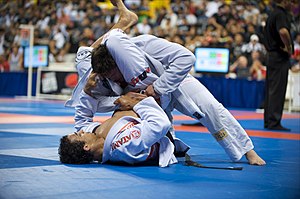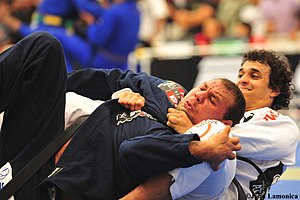
Submission Moves and Techniques from BJJ (Brazilian Jiu-Jitsu) are used often in MMA (Mixed Martial Arts). Submission holds can be grouped into joint locks and chokes. BJJ is very popular amongst the youth across the world today. Joint locks involve isolating the limb and creating a lever with the body position to force the joint to move past its normal range of motion. Pressure is increased in a controlled manner and released if the opponent cannot escape the hold and signals defeat by submitting.
Tap-Out: Opponents can indicate submission verbally or they can tap out (either tap the opponent or the mat). A choke hold, disrupting the blood supply to the brain, can cause unconsciousness if the opponent does not submit or tap out soon enough.

Competition Techniques: Competitions ban or restrict some or all joint locks involving the knees, ankles, and spine. Joint locks that require a twisting motion of the knee like twisting knee locks or twisting knee bars, or techniques such as heel hooks, and toe holds are also usually banned in competitions because successfully completing the move nearly always results in permanent damage that requires surgery. Manipulating the spine is barred due to the inherent danger of crushing or mis-aligning cervical vertebrae. Leglocks are allowed in varying degrees depending on skill level, with straight ankle locks being the only leglocks allowed in the beginner division, straight kneebars being allowed in the intermediate division and toeholds with the pressure applied inwards are allowed in the advanced division. Some competitions also ban submissions involving the crushing or compression of muscle tissue.
Distractions: However, most joint locks involving the wrist, elbow, shoulder or ankle are permitted as there is a great deal more flexibility in those joints and those locks are safe to use under tournament conditions. Also, some fighters practice moves whose sole purpose is to inflict pain upon their opponent, in the hope that they will tap out. This includes driving knuckles into pressure points, holding their opponent’s head in order to tire out the neck and putting body weight on top of the sternum, floating ribs, or similarly sensitive bones. These moves are not true submission moves and used as distractions in lower levels of competition. At upper levels, they are avoided or aggressively countered.

Chokes and Strangles: Often referred to as “air chokes” and “blood chokes”, chokes and strangles are a common forms of submission. In BJJ, the chokes that are used put pressure on the carotid arteries are very fast acting with victims typically losing consciousness in around 3–5 seconds. In contrast, an air choke can take up to two minutes, depending on how long the person can hold their breath, and may cause serious damage to the throat.
Compression: A less common type of submission hold is a compression lock, where the muscle of an opponent is compressed against a hard, large bone such as the shin or wrist, causing pain to the opponent. These types of locks are usually not seen in competition due to the risk of tearing muscle tissue. This type of lock often also hyper-extends the joint in the opposite direction, pulling it apart.
- Rear Naked Choke
- Armbar
- Triangle Choke
- Kimura
- Guillotine Choke
Welcome to ACF - Choose to Change your Life!
To find out more about our courses, you are requested to call us and speak to Sasmira at 9820496752
- A VISIT can then be scheduled to the Academy on a Sat or Sun from 8am to 5pm by prior appointment. Depending upon your needs and requirements, we shall advice on tailormaking a program course for you, choosing from various program options. You shall be counseled extensively by our expert counsellors at no fee for either visit or counseling. Photo ID will be required for entry into the Academy for purposes of security.
- THE FEE will depend upon the time slot, course selected, upon who trains you (Director, Multi Faculty or Instructors) and how many hours program selected by you) Fees are affordable considering the extensive facilities and resulting lifetime of change in personality change and combat dominance.
- JOINING OPTIONS: Thereafter its upto you to join or not. When your course begins, what time slot is desired and other factors may be resolved subsequently on telephonic discussions with our office.
